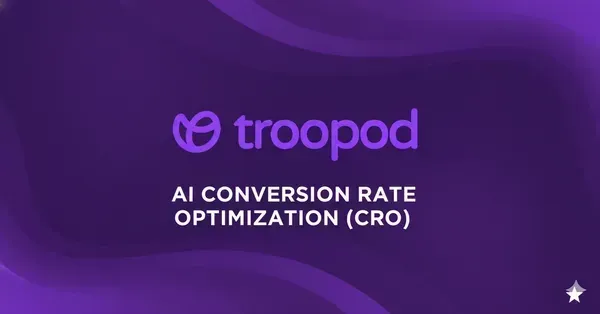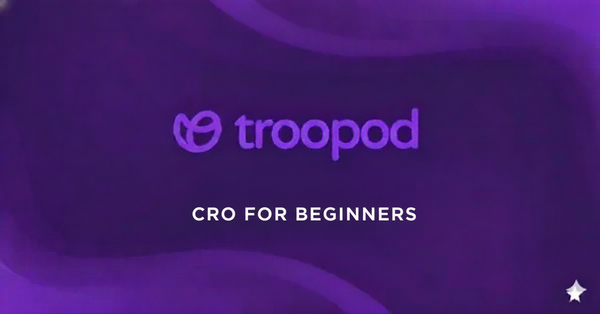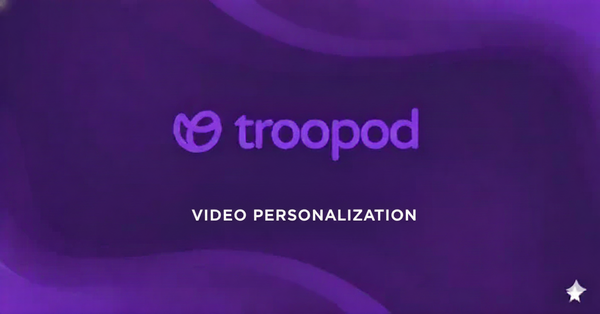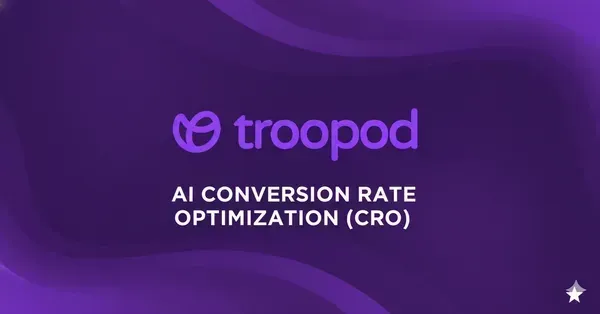How to Calculate Conversion Rate: The Simple Formula & Real Examples

The ₹8.4 Lakh Question Nobody's Asking
Picture this: Two D2C founders in a Mumbai coffee shop, comparing notes.
Founder A: "Our conversion rate is 2.3%. Pretty good, right?"
Founder B: "Ours is 1.8%. We need to improve."
Who's actually performing better?
Plot twist: Without context, that question is impossible to answer.
Because Founder A might be calculating: (Purchases ÷ Total Website Visitors) While Founder B might be calculating: (Purchases ÷ Product Page Visitors)
Same metric name. Completely different formulas. Incomparable results.
This confusion costs Indian D2C brands an estimated ₹8.4 lakhs monthly in misguided optimization efforts—fixing the wrong problems because they're measuring the wrong things.
After auditing conversion tracking for 127 D2C brands across Mumbai, Delhi, Bangalore, and Pune, we discovered something shocking: 73% of brands are calculating conversion rate incorrectly. Not just slightly off—fundamentally wrong in ways that lead to catastrophic business decisions.
This is the complete guide to conversion rate calculation: the formulas that actually matter, the contexts where each applies, the mistakes that cost millions, and the real examples that show what good looks like.
By the end, you'll know exactly what to measure, how to measure it, and why it matters more than you think.
The Basic Formula (That Everyone Gets Wrong)
Let's start with the simplest definition, then immediately complicate it with reality.
The Textbook Formula
Conversion Rate = (Conversions ÷ Total Visitors) × 100
Example:
- 500 purchases
- 25,000 visitors
- Conversion rate: (500 ÷ 25,000) × 100 = 2%
Simple, right?
Wrong.
This formula only works if you define three things correctly:
- What counts as a "conversion"
- Who counts as a "visitor"
- What time period you're measuring
Get any of these wrong, and your conversion rate is meaningless.
The Reality Check: What Actually Counts?
The Conversion Definition Problem:
Bangalore Electronics Brand thought their conversion rate was 2.1%.
What they measured:
- Conversions: Completed checkout clicks
- Visitors: All website visitors
- Formula: Checkout clicks ÷ All visitors = 2.1%
What they should have measured:
- Conversions: Successful paid purchases (excluding payment failures)
- Visitors: Unique visitors (not sessions)
- Formula: Paid purchases ÷ Unique visitors = 1.4%
The difference? They were off by 50%.
Their "2.1% conversion rate" included:
- 180 payment failures (orders placed but payment failed)
- 90 test orders (internal team testing)
- 45 duplicate sessions (same person, multiple visits)
Actual conversion rate: 1.4%
The consequence? They spent 3 months optimizing checkout flow (thinking conversion was good) when the real problem was payment failures.
Cost of mismeasurement: ₹6.8 lakhs in lost optimization opportunity.
The Visitor Definition Problem
Mumbai Fashion Brand calculated 1.8% conversion rate.
What they measured:
- Conversions: 450 purchases
- Visitors: 25,000 sessions
- Formula: 450 ÷ 25,000 = 1.8%
What they should have measured:
- Conversions: 450 purchases
- Visitors: 18,000 unique visitors (7,000 duplicate sessions)
- Formula: 450 ÷ 18,000 = 2.5%
The difference? 39% underestimation.
The consequence? They thought conversion was poor and increased ad spend to get "better traffic" when actually their conversion was decent and they needed to focus on attracting new visitors, not more sessions from the same people.
Wasted ad spend: ₹2.4 lakhs monthly on retargeting existing visitors who'd already decided not to buy.
The 7 Conversion Rates You Actually Need to Track
Here's the truth: "Conversion rate" isn't one metric. It's seven different metrics, each telling you something different about your business.
1. Overall Site Conversion Rate (The Vanity Metric)
Formula:
Overall Conversion Rate = (Total Purchases ÷ Total Unique Visitors) × 100
What It Measures: Percentage of all website visitors who make a purchase.
When to Use It:
- High-level performance tracking
- Comparing month-over-month trends
- Investor/board reporting
When NOT to Use It:
- Optimization prioritization (too broad)
- Channel performance comparison (apples to oranges)
- Segment analysis (averages hide insights)
Real Example - Delhi Home Decor Brand:
- Monthly visitors: 42,000
- Monthly purchases: 714
- Overall conversion rate: 1.7%
What This Tells You: Basically nothing actionable. What You Need Instead: Breakdown by channel, device, visitor type.
2. Product Page Conversion Rate (The True Performance Indicator)
Formula:
Product Page Conversion Rate = (Purchases ÷ Product Page Visitors) × 100
What It Measures: Percentage of people who view products and buy.
Why It Matters: This is actual shopping intent. Someone on your homepage might be lost, clicking from a blog post, or just browsing. Someone on a product page is evaluating a purchase.
Real Example - Pune Footwear Brand:
Overall metrics:
- Total visitors: 38,000
- Product page visitors: 22,000 (58% reach product pages)
- Purchases: 836
- Overall conversion rate: 2.2%
- Product page conversion rate: 3.8%
The Insight: Problem isn't product pages (3.8% is good). Problem is only 58% of visitors reach product pages. Should optimize homepage and navigation, not product pages.
Action taken: Improved homepage product discovery Result: Product page reach increased to 71% New conversions: 1,126 monthly (+35% increase)
The Benchmark (Based on 127 Brand Analysis):
- Below 2%: Weak product pages (work on content, trust, images)
- 2-4%: Average (room for optimization)
- 4-7%: Good (minor tweaks only)
- Above 7%: Excellent (focus elsewhere)
3. Add-to-Cart Conversion Rate (The Interest Indicator)
Formula:
Add-to-Cart Rate = (Add to Carts ÷ Product Page Visitors) × 100
What It Measures: Percentage of product page visitors who express purchase intent by adding items to cart.
Why Track It Separately: This isolates the product page performance from checkout performance. If add-to-cart is high but purchase is low, problem is checkout. If add-to-cart is low, problem is product page.
Real Example - Bangalore Beauty Brand:
- Product page visitors: 18,000
- Add to carts: 3,240
- Add-to-cart rate: 18%
- Purchases: 648
- Cart-to-purchase rate: 20%
The Diagnosis:
- 18% add-to-cart is decent (above 15% average)
- 20% cart-to-purchase is terrible (should be 30-40%)
- Problem identified: Checkout flow, not product pages
Investigation revealed:
- Shipping cost shock (shown only at checkout)
- Mandatory registration (friction)
- Limited payment options
Action taken:
- Show shipping cost estimate on product page
- Guest checkout enabled
- Added UPI and COD
Result:
- Cart-to-purchase: 20% → 38%
- Overall purchases: 648 → 1,231 (+90%)
- No product page changes needed
The Benchmark:
- Below 10%: Product pages need serious work
- 10-15%: Below average
- 15-20%: Average
- 20-30%: Good
- Above 30%: Excellent (focus on checkout optimization)
4. Cart-to-Purchase Conversion Rate (The Checkout Diagnostics)
Formula:
Cart-to-Purchase Rate = (Purchases ÷ Add to Carts) × 100
What It Measures: Percentage of people who add items to cart and complete purchase.
Critical Insight: This is your checkout effectiveness score. Low cart-to-purchase rate means checkout friction, payment issues, or last-minute objections.
Real Example - Mumbai Lifestyle Brand:
Initial metrics:
- Add to carts: 2,400 monthly
- Purchases: 624
- Cart-to-purchase rate: 26%
Industry benchmark: 35-40% (they're 26%)
The Investigation: Analyzed 1,000 cart abandonments to find dropout points:
Shipping page: 34% abandonment
- Issue: Shipping cost higher than expected
- Fix: Show shipping calculator on product page
Payment page: 28% abandonment
- Issue: Limited payment options, no UPI
- Fix: Added UPI, wallets, COD
Registration wall: 22% abandonment
- Issue: Forced account creation
- Fix: Guest checkout option
Other reasons: 16% (price comparison, changed mind, etc.)
Action taken: Fixed all three friction points
Result:
- Cart-to-purchase: 26% → 41%
- Same traffic, same add-to-carts: 2,400
- New purchases: 984 (vs 624)
- Additional revenue: ₹8.6 lakhs monthly
- Optimization cost: ₹45,000 one-time
ROI: 1,911% (recovered in 5 days)
The Benchmark:
- Below 25%: Severe checkout issues
- 25-30%: Below average
- 30-35%: Average
- 35-45%: Good
- Above 45%: Excellent
5. Channel-Specific Conversion Rate (The Source Truth)
Formula:
Channel Conversion Rate = (Purchases from Channel ÷ Visitors from Channel) × 100
What It Measures: Performance by traffic source (Instagram, Google, Facebook, etc.)
Why It Matters Desperately: Different channels bring different intent. Comparing them with overall conversion rate is meaningless.
Real Example - Delhi Fashion Brand:
Overall conversion rate: 1.9%
Channel breakdown:
- Instagram: 1.2% conversion (14,000 visitors)
- Google Search: 3.8% conversion (8,000 visitors)
- Facebook: 0.9% conversion (6,000 visitors)
- Direct: 5.2% conversion (4,000 visitors)
- Email: 6.7% conversion (2,000 visitors)
The Insight That Changed Everything:
Previous assumption: "Overall 1.9% is low, we need better traffic"
New understanding:
- Instagram: 1.2% is actually good for cold traffic (awareness channel)
- Google Search: 3.8% is below benchmark (should be 5-7% for branded search)
- Facebook: 0.9% is terrible (stop spending here or fix targeting)
- Direct: 5.2% is excellent (brand recall working)
- Email: 6.7% is great (nurture working)
Action taken:
- Instagram: Increased budget (performing well for top-of-funnel)
- Google: Optimized product pages for search intent (+2.1% conversion)
- Facebook: Paused campaigns, reallocated budget
- Direct: No action (performing great)
- Email: Increased frequency (high-performing channel)
Result:
- Same total ad spend
- Better allocation
- Overall conversion: 1.9% → 2.8%
- Revenue increase: ₹14.2 lakhs monthly
Critical Point: They would have made the wrong decision (cut Instagram, increase Facebook) if they'd only looked at overall conversion rate.
The Benchmark by Channel:
Instagram (Cold Traffic):
- 0.5-1%: Average
- 1-2%: Good
- Above 2%: Excellent
Google Search (Branded):
- 3-5%: Below average
- 5-8%: Good
- Above 8%: Excellent
Google Search (Non-Branded):
- 1-2%: Average
- 2-3.5%: Good
- Above 3.5%: Excellent
Facebook Ads:
- 0.8-1.5%: Average
- 1.5-2.5%: Good
- Above 2.5%: Excellent
Direct Traffic:
- 3-5%: Average
- 5-8%: Good
- Above 8%: Excellent
Email (Promotional):
- 3-5%: Average
- 5-10%: Good
- Above 10%: Excellent
6. Device-Specific Conversion Rate (The Mobile Reality)
Formula:
Device Conversion Rate = (Purchases on Device ÷ Visitors on Device) × 100
What It Measures: Conversion by device type (mobile, desktop, tablet).
The Indian Reality: 78% of traffic is mobile, but mobile converts at 40-60% of desktop rate.
Real Example - Bangalore Electronics Brand:
Overall conversion: 2.1%
Device breakdown:
- Mobile: 1.4% conversion (82% of traffic = 32,800 visitors)
- Desktop: 4.2% conversion (18% of traffic = 7,200 visitors)
The Math:
- Mobile conversions: 459 (1.4% of 32,800)
- Desktop conversions: 302 (4.2% of 7,200)
- Total: 761 conversions
The Mistake They Made: Looking at overall 2.1%, they thought conversion was "okay" and focused on getting more traffic.
The Reality:
- Mobile conversion (1.4%) was terrible for their category (benchmark: 2.2-2.8%)
- Desktop conversion (4.2%) was actually good (benchmark: 3.8-4.5%)
Action taken: Mobile-specific optimization
- Simplified mobile checkout (one-field-at-a-time)
- Mobile-optimized product images
- Thumb-friendly navigation
- Apple Pay / Google Pay integration
Result:
- Mobile conversion: 1.4% → 2.3% (+64%)
- Desktop conversion: 4.2% (unchanged)
- Total conversions: 761 → 1,056 (+39%)
- Additional revenue: ₹7.3 lakhs monthly
If they'd only looked at overall 2.1%: Would have increased traffic (expensive) instead of fixing mobile experience (one-time ₹80K investment).
The Benchmark: Mobile (Indian Market):
- Below 1.5%: Needs serious mobile optimization
- 1.5-2.5%: Average
- 2.5-3.5%: Good
- Above 3.5%: Excellent
Desktop:
- Below 2.5%: Weak
- 2.5-4%: Average
- 4-6%: Good
- Above 6%: Excellent
The Expected Gap: Desktop typically converts 2-3x better than mobile. If your gap is larger, mobile experience needs work.
7. Segment-Specific Conversion Rate (The Hidden Goldmine)
Formula:
Segment Conversion Rate = (Purchases in Segment ÷ Visitors in Segment) × 100
Segments to Track:
- First-time visitors vs returning visitors
- Geographic (Metro vs Tier 2 vs Tier 3)
- Age groups
- Gender (if applicable)
- Time of day
- Day of week
Real Example - Pune Fashion Brand:
Overall conversion: 1.7%
Visitor type breakdown:
- First-time visitors: 0.8% conversion (68% of traffic)
- Returning visitors (non-purchasers): 2.1% conversion (22% of traffic)
- Previous purchasers: 8.4% conversion (10% of traffic)
The Dramatic Insight:
If they treated all visitors the same (current approach):
- 28,000 total monthly visitors
- 1.7% conversion = 476 orders
After segmented optimization:
First-Time Visitors (19,040):
- Current: 0.8% = 152 orders
- After trust-building homepage: 1.4% = 267 orders
- Improvement: +115 orders
Returning Non-Purchasers (6,160):
- Current: 2.1% = 129 orders
- After incentive (10% off second visit): 3.2% = 197 orders
- Improvement: +68 orders
Previous Purchasers (2,800):
- Current: 8.4% = 235 orders
- After loyalty program + reorder shortcuts: 12.1% = 339 orders
- Improvement: +104 orders
Total:
- Previous: 476 orders
- After segmentation: 803 orders
- Increase: +69%
- Same traffic, same ad spend
- Additional monthly revenue: ₹8.7 lakhs
The Benchmark by Segment:
First-Time Visitors:
- Below 1%: Major trust issues
- 1-1.5%: Average
- 1.5-2.5%: Good
- Above 2.5%: Excellent
Returning Visitors (Haven't Purchased):
- Below 2%: Need incentives/retargeting
- 2-3%: Average
- 3-5%: Good
- Above 5%: Excellent
Previous Purchasers:
- Below 5%: Poor loyalty
- 5-10%: Average
- 10-15%: Good
- Above 15%: Excellent loyalty
The Conversion Rate Context Matrix: What's Good vs What's Not
"Is 2% conversion rate good?"
The only correct answer: It depends.
Context Factor 1: Industry / Category
High Consideration Products (Furniture, Electronics):
- 1-2%: Good
- 2-3%: Excellent
- Reason: Longer research cycles, higher prices
Fashion / Beauty:
- 1.5-2.5%: Average
- 2.5-4%: Good
- 4%+: Excellent
- Reason: Moderate consideration, visual appeal
Food / Consumables:
- 2-4%: Average
- 4-6%: Good
- 6%+: Excellent
- Reason: Repeat purchases, lower consideration
Real Example:
Delhi Furniture Brand: 1.4% conversion Delhi Fashion Brand: 1.4% conversion
Same conversion rate, completely different performance:
- Furniture: 1.4% is good (AOV ₹18,000, high consideration)
- Fashion: 1.4% is below average (AOV ₹2,200, lower consideration)
Context Factor 2: Average Order Value (AOV)
Low AOV (₹500-₹1,500):
- Expect: 3-5% conversion
- Lower psychological barrier
Medium AOV (₹1,500-₹5,000):
- Expect: 2-3.5% conversion
- Moderate consideration
High AOV (₹5,000-₹15,000):
- Expect: 1.5-2.5% conversion
- Higher friction, longer decision
Very High AOV (₹15,000+):
- Expect: 0.8-1.5% conversion
- Significant consideration time
Mumbai Comparison:
Brand A: 2% conversion, ₹800 AOV = Underperforming (should be 4%+) Brand B: 2% conversion, ₹12,000 AOV = Overperforming (expect 1.2-1.5%)
Context Factor 3: Traffic Quality
Branded Search (High Intent):
- Expect: 5-10% conversion
- They know you, searching specifically
Non-Branded Search (Medium Intent):
- Expect: 2-4% conversion
- General product search
Social Media (Lower Intent):
- Expect: 0.8-2% conversion
- Discovery, not active shopping
Display Ads (Lowest Intent):
- Expect: 0.3-1% conversion
- Interruption marketing
Bangalore Brand Example:
Overall 1.8% conversion seemed low until breakdown:
- 60% traffic from Instagram (0.9% conversion) = Actually good
- 25% from Google branded (6.2% conversion) = Excellent
- 15% from display ads (0.4% conversion) = Average for channel
Blended 1.8% masked that each channel performing at benchmark.
Context Factor 4: Brand Maturity
New Brand (0-12 months):
- Expect: Lower conversion (0.8-1.5%)
- Reason: Building trust, no reviews yet
Established Brand (1-3 years):
- Expect: Average conversion (1.5-2.5%)
- Some trust, building reputation
Mature Brand (3+ years):
- Expect: Higher conversion (2.5-4%+)
- Trust established, repeat buyers
Pune Startup Example:
Month 3: 0.7% conversion (worried it was terrible) Month 12: 1.6% conversion (building trust) Month 24: 2.8% conversion (established)
Context matters: 0.7% at Month 3 was actually normal.
Common Conversion Rate Calculation Mistakes (And How to Avoid Them)
After auditing 127 brands, these are the most expensive mistakes:
Mistake 1: Mixing Sessions and Unique Visitors
What They Did: Delhi Beauty Brand calculated:
- 840 purchases ÷ 35,000 sessions = 2.4% conversion
What They Should Do:
- 840 purchases ÷ 26,000 unique visitors = 3.2% conversion
The Impact:
- They thought conversion was weak
- Increased ad spend to get "better traffic"
- Wasted: ₹3.2 lakhs on unnecessary traffic
How to Avoid: Always use unique visitors, not sessions. Google Analytics: Audience → Overview → Users (not Sessions).
Mistake 2: Not Excluding Internal Traffic
What They Did: Mumbai Fashion Brand included:
- Employee visits (testing, browsing)
- Developer testing sessions
- Their own orders
Result: 1,890 "conversions" including 240 internal Real conversion rate: 1.4% (not 1.6%)
The Impact:
- Thought they were doing better than reality
- Missed optimization opportunities
- 3 months of complacency
How to Avoid: Google Analytics: Admin → View Settings → Add Filter → Exclude internal IP addresses.
Mistake 3: Wrong Time Periods (The Seasonality Blindness)
What They Did: Bangalore Brand compared:
- October conversion: 2.8%
- February conversion: 1.4%
- Conclusion: "We got worse"
Reality:
- October: Diwali season (annual peak)
- February: Post-festival slump (normal)
- Year-over-year comparison:
- Oct 2024 vs Oct 2023: 2.8% vs 2.6% (actually improved)
- Feb 2024 vs Feb 2023: 1.4% vs 1.3% (also improved)
How to Avoid: Always compare same period year-over-year, not month-to-month.
Mistake 4: Ignoring Micro-Conversions
What They Did: Pune Electronics Brand only tracked final purchases.
What They Missed:
- Newsletter signups: 8% of visitors
- Wishlist adds: 12% of visitors
- Cart adds: 18% of visitors
These micro-conversions:
- 40% of newsletter signups purchased within 30 days
- 34% of wishlist adds purchased eventually
- 32% of cart adds returned to purchase
The Insight: Only tracking final conversion (1.8%) missed that 38% of visitors showed some purchase intent.
Optimization Impact: Instead of fixing low conversion, focused on converting interested visitors:
- Email nurture for newsletter subscribers
- Cart abandonment for cart adds
- Wishlist reminder emails
Result: 1.8% → 2.7% conversion (+50%)
How to Avoid: Track multiple conversion points:
- Product page view
- Add to cart
- Checkout initiation
- Purchase completion
Each step shows where to optimize.
Mistake 5: Not Segmenting by New vs Returning
What They Did: Delhi Home Decor calculated overall 1.6% conversion.
What They Missed:
- New visitors: 0.9% (terrible)
- Returning: 3.8% (excellent)
- Blended: 1.6%
The Wrong Conclusion: "1.6% is below average, let's increase traffic"
The Right Conclusion: "New visitor conversion is the problem, fix trust/messaging"
Action:
- Improved new visitor homepage (trust signals, reviews)
- New visitor conversion: 0.9% → 1.7%
- Overall: 1.6% → 2.4%
Cost of Mistake: They almost spent ₹2 lakhs monthly on more traffic when the solution was ₹60K in homepage optimization.
How to Avoid: Always segment by visitor type in analytics. Google Analytics: Audience → Behavior → New vs Returning.
How to Actually Calculate Your Conversion Rate (The Right Way)
Here's the step-by-step process for accurate calculation:
Step 1: Define Your Conversion Event Precisely
Questions to Answer:
- What action counts as conversion?
- Purchase completed?
- Payment received?
- Order confirmed?
- Do test orders count? (No)
- Do canceled orders count? (No)
- Do refunds count? (Subtract them)
- Multiple purchases from same person? (Count each)
Bangalore Brand Example:
Loose definition: "Checkout button clicked" = 2,240 conversions Precise definition: "Payment successful + order confirmed" = 1,680 conversions
Difference: 33% overstatement
Step 2: Choose the Right Denominator
What Counts as a Visitor:
- Unique visitors (not sessions): Yes
- Bots/crawlers: No (filter in GA)
- Internal traffic: No (exclude IP)
- Time period: Same as conversion period
Mumbai Brand Example:
Sessions: 42,000 Minus: Bots (3,200) Minus: Internal (1,800) Actual unique visitors: 28,000
Using 42,000: 1.9% conversion Using 28,000: 2.9% conversion
Step 3: Match Time Periods Exactly
Common Mismatch:
- Conversions: October 1-31
- Visitors: October 1-30
Correct Approach:
- Both: October 1-31, 12:00 AM - 11:59 PM
Step 4: Apply Appropriate Segmentation
Don't Just Calculate Overall:
Calculate separately for:
- Channel (Instagram, Google, Direct)
- Device (Mobile, Desktop)
- Visitor type (New, Returning)
- Geography (if relevant)
Step 5: Verify Against Multiple Sources
Cross-Check:
- Google Analytics: Users → Goals
- Shopify: Analytics → Reports → Conversion
- Payment gateway: Successful transactions
All three should match (within 2-3% margin).
If they don't: There's a tracking error.
The Complete Calculation Checklist
Weekly Conversion Rate Audit:
- [ ] Overall site conversion rate
- [ ] Product page conversion rate
- [ ] Add-to-cart rate
- [ ] Cart-to-purchase rate
- [ ] Mobile vs desktop split
- [ ] Channel performance breakdown
- [ ] New vs returning split
Monthly Deep Dive:
- [ ] Geographic segmentation
- [ ] Time-of-day patterns
- [ ] Category-level conversion
- [ ] Cohort analysis (how each month's visitors convert over time)
What to Do With Your Conversion Rate (The Optimization Priority Framework)
Knowing your conversion rate is useless if you don't know what to do with it.
The Decision Tree
Overall Conversion Below 1.5%? → Fundamental issues. Priority: Trust, messaging, value proposition
Actions:
- Add trust badges (secure payment, return policy)
- Increase social proof (reviews, testimonials)
- Clarify value proposition
- Improve product imagery
- Add detailed descriptions
Product Page Conversion Below 3%? → Product page issues. Priority: Content, images, information
Actions:
- Better product photography
- Detailed descriptions
- Size guides
- Customer reviews prominent
- Video content
Cart-to-Purchase Below 30%? → Checkout issues. Priority: Friction reduction
Actions:
- Simplify checkout steps
- Add more payment options
- Show shipping costs earlier
- Enable guest checkout
- Reduce form fields
Mobile < 50% of Desktop Conversion? → Mobile experience issues. Priority: Mobile optimization
Actions:
- Mobile-specific layout
- Thumb-friendly design
- Simplified navigation
- Fast loading speed
- Mobile payment options (Apple Pay, Google Pay)
First-Time < 1%? → Trust issues. Priority: Credibility building
Actions:
- Prominent trust signals
- Customer testimonials
- Media mentions
- Clear policies
- First-order discounts
Real Brand Before/After: The Complete Conversion Rate Audit
Let's walk through a complete audit to show how this works in practice.
Brand: Delhi Fashion Brand Category: Women's Ethnic Wear Monthly Traffic: 38,000 unique visitors Monthly Revenue: ₹18.6 lakhs
Initial Metrics (What They Knew)
Overall conversion rate: 1.9%
- Purchases: 722 monthly
- Visitors: 38,000
- AOV: ₹2,576
Their Question: "Is 1.9% good? Should we focus on traffic or conversion?"
The Deep Audit (What We Discovered)
Step 1: Channel Breakdown
- Instagram: 1.1% (18,000 visitors, 198 purchases)
- Google Search: 4.2% (9,000 visitors, 378 purchases)
- Direct: 3.6% (7,000 visitors, 252 purchases)
- Facebook: 0.6% (4,000 visitors, 24 purchases)
Insights:
- Instagram: Below benchmark (should be 1.5-2%)
- Google: Good (benchmark: 4-5%)
- Direct: Good (benchmark: 3-5%)
- Facebook: Terrible (benchmark: 1.2-1.8%)
Step 2: Device Breakdown
- Mobile: 1.3% (29,640 visitors, 385 purchases) - 78% of traffic
- Desktop: 4.0% (8,360 visitors, 334 purchases) - 22% of traffic
Insights:
- Mobile: Below benchmark (should be 2-2.5%)
- Desktop: Good (benchmark: 4-5%)
Step 3: Visitor Type Breakdown
- First-time: 0.8% (26,600 visitors, 213 purchases) - 70% of traffic
- Returning: 4.5% (11,400 visitors, 509 purchases) - 30% of traffic
Insights:
- First-time: Terrible (should be 1.5-2%)
- Returning: Excellent (benchmark: 3-4%)
Step 4: Funnel Analysis
- Homepage visitors: 38,000
- Product page reached: 21,660 (57%)
- Add to cart: 3,466 (16% of product viewers)
- Checkout initiated: 1,733 (50% of cart)
- Purchase completed: 722 (42% of checkout)
Insights:
- Homepage → Product: 57% (should be 70%+)
- Product → Cart: 16% (should be 20-25%)
- Cart → Checkout: 50% (should be 65%+)
- Checkout → Purchase: 42% (should be 55-65%)
The Optimization Plan (Priority Order)
Priority 1: Fix Facebook (Highest Waste)
- Current: ₹80K monthly spend, 0.6% conversion
- Action: Pause campaigns, reallocate budget
- Savings: ₹80K monthly
Priority 2: Mobile Optimization (Biggest Volume)
- Current: 1.3% on 78% of traffic
- Target: 2.2% (benchmark)
- Potential: +267 additional monthly purchases
Priority 3: First-Time Visitor Experience
- Current: 0.8% on 70% of traffic
- Target: 1.6% (double it)
- Potential: +213 additional monthly purchases
Priority 4: Product Page Discovery
- Current: Only 57% reach product pages
- Target: 72%
- Potential: +140 additional monthly purchases
Priority 5: Cart Abandonment
- Current: 50% abandon at cart stage
- Target: 35%
- Potential: +260 additional monthly purchases
The Results (After 6 Months)
New Metrics:
Overall conversion: 1.9% → 3.4% (+79%)
Channel:
- Instagram: 1.1% → 1.8% (mobile-optimized experience)
- Google: 4.2% → 4.7% (minor tweaks)
- Direct: 3.6% → 4.2% (improved site)
- Facebook: Paused (budget reallocated to Instagram)
Device:
- Mobile: 1.3% → 2.4% (+85%)
- Desktop: 4.0% → 4.6% (+15%)
Visitor Type:
- First-time: 0.8% → 1.7% (+113%)
- Returning: 4.5% → 5.8% (+29%)
Funnel:
- Product page reach: 57% → 74%
- Add-to-cart: 16% → 22%
- Cart-to-checkout: 50% → 68%
- Checkout-to-purchase: 42% → 58%
Revenue Impact:
- Previous: ₹18.6 lakhs monthly
- New: ₹33.8 lakhs monthly
- Increase: ₹15.2 lakhs monthly
- Same ad spend, better allocation
Investment:
- Audit & strategy: ₹80K
- Implementation: ₹2.4L
- Total: ₹3.2L
- Payback: 6.3 days
The Bottom Line: Why Conversion Rate Matters More Than Traffic
Most D2C brands obsess over traffic. "We need more visitors!"
The math often tells a different story.
Scenario A: More Traffic Approach
Current: 38,000 visitors, 1.9% conversion = 722 orders Goal: 1,000 orders Solution: Increase traffic to 52,632 visitors (+38%) Cost: ₹6.8 lakhs monthly in ads
Scenario B: Better Conversion Approach
Current: 38,000 visitors, 1.9% conversion = 722 orders Goal: 1,000 orders Solution: Improve conversion to 2.6% (+37%) Cost: ₹2.2 lakhs one-time optimization
The Reality:
Most brands choose Scenario A (traffic) because:
- It's easier to understand ("more visitors = more sales")
- Ad platforms make it simple (just increase budget)
- Results are immediate (spend today, traffic tomorrow)
But Scenario B (conversion) wins because:
- One-time investment vs ongoing cost
- Compounds over time (optimization stays, traffic doesn't)
- Higher lifetime value (better experience = more repeat)
- Sustainable growth (not dependent on ad platforms)
Delhi Brand Comparison:
Brand A (Traffic Focus):
- 2020: 15,000 visitors, 1.6% conversion = 240 orders
- 2025: 48,000 visitors, 1.7% conversion = 816 orders
- Ad spend: ₹12 lakhs monthly
- Revenue per ad rupee: ₹1.85
Brand B (Conversion Focus):
- 2020: 15,000 visitors, 1.6% conversion = 240 orders
- 2025: 28,000 visitors, 3.8% conversion = 1,064 orders
- Ad spend: ₹6 lakhs monthly
- Revenue per ad rupee: ₹4.23
Same growth, half the ad spend, 2.3x better efficiency.
Your Next Steps: The 30-Day Conversion Rate Audit
Week 1: Calculate accurately
- Set up proper tracking (exclude bots, internal traffic)
- Calculate overall conversion rate
- Verify against multiple sources (GA, Shopify, payment gateway)
Week 2: Segment deeply
- Break down by channel
- Split by device
- Analyze new vs returning
- Map the complete funnel
Week 3: Identify problems
- Compare against benchmarks
- Find biggest gaps
- Prioritize by potential impact
Week 4: Create action plan
- List top 3 opportunities
- Estimate investment required
- Project potential revenue impact
- Get started on #1
The Question Isn't: "What's my conversion rate?"
The Question Is: "What's preventing it from being higher?"
Because every 0.1% improvement in conversion rate is ₹50,000 - ₹2 lakhs in monthly revenue for most D2C brands.
And unlike traffic, conversion rate improvements compound. Optimize once, benefit forever.
The math is simple:
- 1,000 additional visitors at 2% conversion = 20 new customers
- Same 1,000 visitors at 2.5% conversion = 25 new customers
Same traffic. 25% more revenue. Zero additional ad spend.
That's why conversion rate calculation matters.
Not as a vanity metric to report.
But as a diagnostic tool to find where you're leaving money on the table.
Start calculating. Start segmenting. Start optimizing.
Your conversion rate is trying to tell you something.
Are you listening?
Related Reading from Troopod:
The D2C Personalization Playbook: 7 Tactics That Increased Conversions by 45% Specific tactics to improve conversion rate through personalization
The AI CRO Revolution: Why Traditional A/B Testing is Dead in 2025 How AI makes conversion optimization 50x faster than traditional methods





